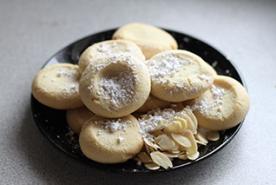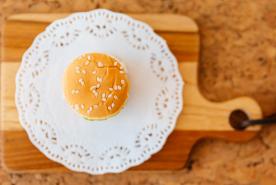Learn how to limit sodium in your CKD diet. Use herbs and spices for flavor instead of salt to manage blood pressure and fluid balance.
How much sodium should I eat as part of a healthy diet?
Most Americans have too much sodium in their diet. A healthy diet should include no more than 2300mg of sodium per day.
Looking for nutrition guidance? Contact a kidney dietitian in your area.
How can I reduce sodium in my diet?
There are many herbs and spices that you can use to add flavor to your food instead of salt. Also, certain foods have more sodium than others. See the following table for some suggestions on how to reduce sodium in your diet:
| Limit the Amount of… | Food to Limit Because of their High Sodium Content | Acceptable Substitutes |
|---|---|---|
| Salt & Salt Seasonings |
| Fresh garlic, fresh onion, garlic powder, onion powder, black pepper, lemon juice, low- sodium/salt-free seasoning blends, vinegar |
| Salty Foods | High Sodium Sauces such as:
| Homemade or low-sodium sauces and salad dressings; vinegar; dry mustard; unsalted crackers, popcorn, pretzels, tortilla, or corn chips |
| Cured Foods |
| Fresh beef, veal, pork, poultry, fish, eggs |
| Luncheon Meats |
| Low-salt deli meats (if you need to limit phosphorus, these are likely high in phosphorus) |
| Processed Foods |
| Natural cheese (1-2 oz per week) Homemade or reduced-sodium soups, canned food without added salt Homemade casseroles without added salt, made with fresh or raw vegetables, fresh meat, rice, pasta, or no added salt canned vegetables |
Why do I need to limit my sodium intake?
Some salt or sodium is needed for body water balance. But when your kidneys lose the ability to control sodium and water balance, you may experience the following:
- thirst
- fluid gain
- high blood pressure
- discomfort during dialysis
By using less sodium in your diet, you can control these problems.
Hints to keep your sodium intake down
Cook with herbs and spices instead of salt. (Refer to “Spice Up Your Cooking” section for further suggestions.)
Read food labels and choose those foods low in sodium.
If you need to limit potassium avoid salt substitutes (such as potassium chloride) and specialty low-sodium foods made with salt substitutes because they are high in potassium.
When eating out, ask for foods prepared without salt. Ask for gravy or sauce on the side; these may contain large amounts of salt and should be used in small amounts.
Limit use of canned, processed, and frozen foods.
Some information about reading labels
Understanding the terms:
Sodium Free - Only a trivial amount of sodium per serving.
Very Low Sodium - 35 mg or less per serving.
Low Sodium - 140 mg or less per serving.
Reduced Sodium - Foods in which the level of sodium is reduced by 25%.
Light or Lite in Sodium - Foods in which the sodium is reduced by at least 50%.
Simple rule of thumb: If salt is listed in the first five ingredients, the item is probably too high in sodium to use.
All food Nutrition Facts labels have milligrams (mg) of sodium listed. Follow these steps when reading the sodium information on the label:
Know how much sodium you are allowed each day. Remember that there are 1000 milligrams (mg) in 1 gram. For example, if your diet prescription is 2.3 grams of sodium, your limit is 2300 milligrams per day. Consider the sodium value of other foods you plan to eat during the day.
Look at the package label. Check the serving size. Nutrition values are expressed per serving. How does this compare to your total daily allowance? In general, the item is not a good choice if:
The sodium level is 240 mg or more per serving, the item is not a good choice.
The milligrams of sodium are greater than the calories per serving
Compare labels of similar products. Select the lowest sodium level for the same serving size.
What kinds of spices and herbs should I use instead of salt to add flavor?
Try the following spices with the foods listed.
Allspice:
Use with beef, fish, beets, cabbage, carrots, peas, fruit.
Basil:
Use with beef, pork, most vegetables, whole grain pasta.
Bay Leaf:
Use with beef, pork, most vegetables, soups, and stews.
Cilantro
Use with chicken and seafood.
Caraway:
Use with beef, pork, green beans, cauliflower, cabbage, beets, asparagus, and in dips and marinades.
Cardamom:
Use with fruit and in baked goods.
Curry:
Use with beef, chicken, pork, fish, chickpeas, green beans, carrots and in marinades.
Dill:
Use with beef, chicken, green beans, cabbage, carrots, peas and in dips.
Ginger:
Use with beef, chicken, pork, green beans, cauliflower, and eggplant.
Marjoram:
Use with beef, chicken, pork, green beans, cauliflower, and eggplant.
Rosemary:
Use with chicken, pork, cauliflower, peas, rice, and in marinades.
Thyme:
Use with beef, chicken, pork, fish, green beans, beets, and carrots.
Sage:
Use with chicken, pork, eggplant and in dressing.
Tarragon:
Use with fish, chicken, asparagus, beets, cabbage, cauliflower, potatoes, salads, and in marinades.
Tips for cooking with herbs and spices
Purchase spices and herbs in small amounts. When they sit on the shelf for years, they lose their flavor.
Use no more than ¼ teaspoon of dried spice (¾ of fresh) per pound of meat.
Add ground spices to food about 15 minutes before the end of the cooking period.
Add whole spices to food at least one hour before the end of the cooking period.
Combine herbs with oil or butter, set for 30 minutes to bring out their flavor, then brush on foods while they cook, or brush meat with oil and sprinkle herbs one hour before cooking.
Crush dried herbs before adding to foods.
Here are some seasoning recipes:
When using the following seasoning recipes, make sure to blend well. Place in a shaker.
American Favorite Blend
5 tsp. onion powder (not onion salt)
1 Tbsp. garlic powder
1 Tbsp. paprika
1 Tbsp. dry mustard
1 tsp. thyme
½ tsp. white pepper
½ tsp. celery seeds
Yield: about ¼ cup (Health Education Assc. Inc., Glenside, PA)
Savory Seasoning
1 ¼ tsp. celery seed
2 Tbsp. crushed marjoram
2 Tbsp. crushed savory
2 Tbsp. crushed thyme
1 Tbsp. crushed basil
Yield: about ½ cup (Nutrition: The Art of Good Eating, Seattle, WA)
Spicy Seasoning
3 Tbsp. celery seed
1 Tbsp. onion powder
1 tsp. garlic powder
2 Tbsp. crushed oregano
1 Tbsp. crushed thyme
1 ½ tsp. ground bay leaf
1 ½ tsp. black pepper
1 ½ tsp. ground cloves
Yield: about ½ cup (Nutrition: The Art of Good Eating, Seattle, WA)
Savory Seasoning Savory Blend
1 tsp. chili powder
2 tsp. ground oregano
2 tsp. black pepper
1 Tbsp. garlic powder
6 Tbsp. onion powder
2 Tbsp. dry mustard
3 Tbsp. paprika
3 Tbsp. poultry seasoning
Yield: about ¾ cup (South Carolina Dept. of Health and Environmental Services)
Experiment and create your own seasoning containing those spices that you like.
If you would like more information, please contact us.
Acknowledgment: Reviewed by the Council on Renal Nutrition
© 2021 National Kidney Foundation. All rights reserved. This material does not constitute medical advice. It is intended for informational purposes only. Please consult a physician for specific treatment recommendations.

















